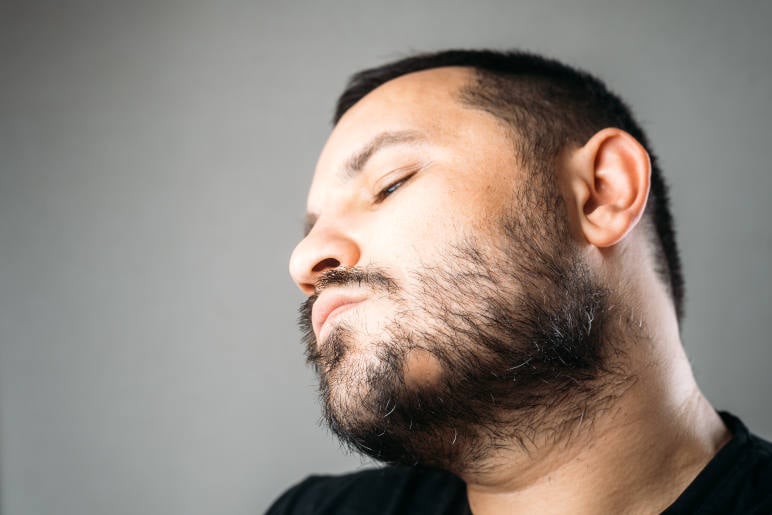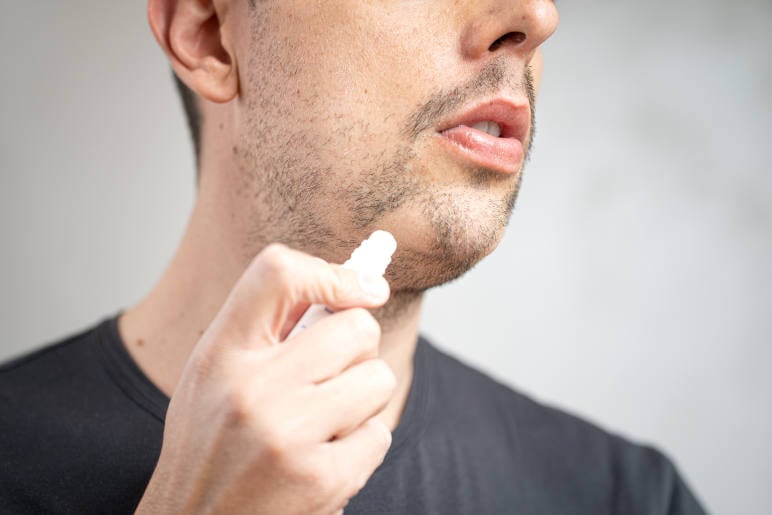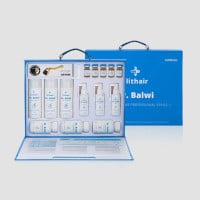
How to Fix Bald Spots in Your Beard: A Guide for Men with Alopecia Barbae
If you are reading this, it means that you have most likely encountered someone, or are facing issues with bald spots in your beard – known as Alopecia Barbae. As a rare form of facial hair loss, it can affect men at any stage of their life. In order to keep you prepared and prepped on how to deal with it – we have compiled information to give you the best guidance possible on its identification, effects, and possible treatments.
What Is Alopecia Barbae?
You might already be familiar with more well-known conditions such as alopecia totalis, which leads to hair loss on your scalp alone, and alopecia areata, which causes sporadic hair loss on your scalp, face, or throughout the body.
However, less is known about the rare Alopecia Barbae, which is a type of alopecia that causes hair to fall in round bald patches in the beard. These bald spots are caused by an autoimmune disease of the hair follicle, which consequently inhibits hair growth. Here, antibodies attack the hair roots because it identifies them as foreign cells.
The number of bald spots depends on the severity of your condition. Beard hair loss can appear as 1 or 2 patches, or more throughout your facial hair. Hairless patches on your neck, cheeks, moustache, and beard are some of the common symptoms.
This beard alopecia is a form of Alopecia Areata (AA) that only causes symptoms i n the beard area. As a result, it is also medically known as Alopecia Areata Barbae (AAB).
What Are the Symptoms of Alopecia Barbae?
The symptoms of beard alopecia vary in severity. Some patients may lose all of their beard hair, while others may only lose small patches. However, the condition usually begins with one or two patches.
The 5 main symptoms of Alopecia Barbae are:
- Circular, coin-sized smooth bald patches
- Only white hairs (if any) left in the bald areas
- Exclamation mark hairs surrounding the patches
- A tingling sensation in the affected areas
- Itchiness

What Causes Beard Alopecia?
Just like the cause of AA, it’s unknown why the immune system starts to attack the beard hair in these cases of alopecia barbae. It often appears in a more defined pattern than other types of patchy beard issues. Patients have typically thought that it’s triggered by an injury, shock or by another kind of autoimmune disease. Furthermore, research is still being conducted to determine why the hair follicles are rejected by the immune system.
Furthermore, a study suggested that BAA could be linked to other autoimmune conditions such as atopic dermatitis, vitiligo, and psoriasis. The main Alopecia Barbae causes include:
- Autoimmune Disease – If you have an autoimmune disease (such as atopic dermatitis, thyroid disease, anemia, psoriasis, etc) you are indeed more likely to develop Alopecia Barbae. A study carried out by Muller and Winkelmann concluded that the formation of organ-specific autoantibodies that play a pathogenic role is active in both alopecia and other autoimmune disorders.
- Genetics – There is a greater risk of developing beard alopecia if there is someone in your family who also has a form of alopecia.
- Other Alopecias – If you have a form of alopecia that’s affecting your scalp hair or someone else on your body, then there is a chance that it can develop into AAB.
How Do You Know if You Have Alopecia From an Autoimmune Disease?
There are some common medical conditions that are frequently misdiagnosed as Alopecia Areata Barbae. In fact, the clinical symptoms of AAB are very similar to ringworm, and the side effects of chemotherapy.
Ringworm
Symptoms of ringworm include scaly bald patches on your beard (or anywhere on your body), itchy skin, hair loss and a ring-shaped rash. Ringworm is an infection caused by dermatophyte fungus, typically called Tinea Barbae. This can be remedied with antifungal drugs taken orally.
Chemotherapy
Cancer treatment that uses chemotherapy has a side effect of hair loss (called chemo-induced alopecia). Not everyone loses their hair from chemo, however, others experience hair shedding on their scalp as well as their beard, eyebrows, and eyelashes. This is due to the condition known as anagen effluvium, which is a type of sudden hair loss and is caused by chemotherapy treatment for cancer. The hair is expected to grow back on its own after chemotherapy has finished.

Diagnosis of Alopecia Areata Barbae
Currently, there is no cure for alopecia barbae. Your doctor can only prescribe treatments to treat and manage your current inflammation or irritation. During the diagnosis, your doctor may take a sample of your facial hair for examination. That is to exclude any other conditions that might cause hair loss like thyroid disorders or fungal infections.
To detect infections or underlying medical conditions, such as autoimmune disorders, your doctor may need to perform a scalp biopsy or blood test.
At Elithair, this is done through extensive processes and tests and handled under expert supervision before any treatment is suggested.
What Are the Best Alopecia Barbae Treatments?
Unfortunately, there is no one-all cure for Alopecia Areata Barbae, but the good news is that there are viable options available to help make the symptoms go away. There are numerous treatment options for BAA, and the choice of therapy relies on various factors, including the severity of the condition, the affected area’s extent, the duration of the disease, and the patient’s age.
- PRP Treatment
In April 2020, Hanno Pototschnig and Maximilian T Madi published a study of the successful treatment of Alopecia Barbae with Platelet-Rich Plasma (PRP) treatment. PRP has been considered an effective treatment for some types of alopecia, i.e. male pattern baldness. - Immunotherapy
Contact immunotherapy treatments are designed to cause skin irritation which distracts the immune system, thus preventing it from attacking the hair follicles.
The goal of this treatment is to trigger an allergic skin reaction that stimulates hair regrowth in the bald spot on your beard. - Corticosteroids
Steroid injections and topical steroid creams are prescribed for various types of alopecia. For Alopecia Barbae, steroid cream is also an effective treatment for encouraging hair to grow.
Is a Beard Transplant Effective for Alopecia Barbae Recovery?
AAB is caused by an autoimmune disease that doesn’t recognise the body’s own hair follicles, so attacks them. Unfortunately, when your hair moves to a different area of your beard, your immune system will still fight your hair follicles. Because of this, a hair transplant isn’t recommended for Alopecia Barbae.
On the other hand, if you have a patchy beard that isn’t caused by AAB, then a beard hair transplant is recommended in this case. If you would like to thicken or fill in any gaps in your beard, then this method of hair restoration is ideal.
Living With Alopecia Barbae
Dealing with unexpected issues in your beard and face do not effect you medically. That is the good news. However, any unexpected or seemingly uncontrollable issues on the face can come with their fair share of psychological impacts. You should know that there are ways to deal with it.
Handling changes calmly and with a clear mind is important. You should consider seeking therapy or joining a support group to overcome any fears.
Can Alopecia Barbae Come Back After Treatment?
Unfortunately, this condition may return, even after various treatments, this condition could resurface after attempted treatments, as is the case with Alopecia Aerata wherein 30 percent of individuals find that the condition resurfaces over time.
For most of the scenarios outlined above, barring autoimmune situations, you may be eligible for a hair transplant should the condition keep persisting. It’s a big decision to get a hair transplant, but should you choose to, we are there every step of the way. Get in touch with our experts to find out about possibilities for you.
FAQ
Can alopecia barbae affect other facial hair areas besides the beard?
Yes, alopecia barbae can also impact areas such as the moustache, sideburns, and eyebrows, leading to patchy hair loss in these regions.
How long does it take for hair to regrow after treating alopecia barbae?
Hair regrowth can vary, but it typically takes a few months to see initial results. Full regrowth may take up to a year, depending on the effectiveness of the treatment and individual response.
Are there any dietary changes that can help manage alopecia barbae?
A balanced diet rich in vitamins and minerals, particularly those that support hair health like biotin, zinc, and vitamin D, can help manage symptoms and promote regrowth.
Can stress management techniques help with alopecia barbae?
Yes, stress management techniques such as meditation, exercise, and adequate sleep can help reduce the severity and frequency of alopecia barbae flare-ups.
Is alopecia barbae more common in certain age groups?
Alopecia barbae can occur at any age, but it is more commonly diagnosed in adults, particularly those in their 30s and 40s.


